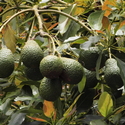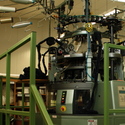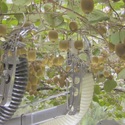The value of the horticultural industry will increase with better pollination systems, robust quality control, better traceability systems, more cost-competitive practice and solutions for the difficulty of finding seasonal orchard crews.
How are some of these challenges being addressed?
Tauranga-based company Robotics Plus believes the time is ripe for innovative automation in the horticultural industry and is working to produce world-leading export technology.
Creating Robotics Plus
Steve Saunders is the founder and managing director of Robotics Plus. He began working in the industry in fruit packhouses. Early on, he recognised the need for innovation to ensure efficiency, best practice and cost-competitiveness. Steve’s vision and industry knowledge collided with technical know-how when he met mechatronics engineer Dr Alistair Scarfe.
Both men wanted to develop technology and capability with a focus on automated systems for horticulture. Robotics Plus was set up to focus on developing mechanisation, automation, robotics and sensor (MARS) technologies for horticulture and other primary industries.
Mechatronics
Mechatronics is robot technology that combines electronics, computer programming and mechanical engineering. Sensor technology and electricity are important components of this work.
Take a closer look at the use of mechatronics in the meat industry and research into search and rescue robots.
The QuadDuster
First up for Robotics Plus was the QuadDuster, a quadbike-based kiwifruit pollination system. It was a natural starting place because of the connection with Steve’s kiwifruit pollen business, Pollen Plus. Pollen Plus harvests and processes kiwifruit pollen to sell to orchardists.
The QuadDuster system was developed to improve pollination of kiwifruit – pollination is vital for fruit yield and quality. Pollen is like gold – expensive and precious. The QuadDuster allows for the even distribution of dry pollen into the vine canopy. Spreading the pollen as a dry powder, as opposed to it being mixed in a water solution, allows for bees to collect and transfer dry pollen that didn’t land directly on the flowers’ stigma during application.
The entire system is electronically controlled. This includes pollen dispenser monitoring to ensure consistent delivery, set-speed cruise control on the quad bikes and GPS tracking to show the orchardist where the bikes have been.
In 2015, QuadDusters were used in about 25% of New Zealand’s kiwifruit industry, and this is set to grow.
The QuadDuster provided a proof of concept, demonstrating how Robotics Plus could capitalise on orchard technology. Importantly, QuadDusters are leased, reducing capital costs and maintenance issues for orchardists.
The automated technology has to be cost-effective for both Robotics Plus and the end user. Alistair points out that anyone can create clever automated systems with an endless budget, whereas they wanted to create systems that were not just comparable to current orchard costs but were more cost-effective. Alongside its industry insider knowledge, this is a key point of difference that Robotics Plus brings to orchard automation – the driving need to make systems that are genuinely economic and practical for commercial use.
Pollination problems
Insufficient pollination of kiwifruit flowers has been linked to small and misshapen fruit that are not suitable for export markets and therefore reduce returns to growers.
Learn more about pollination problems in the kiwifruit and avocado industries.
The Robotic Apple Packing Cell
The Robotic Apple Packing Cell went into commercial trial in the 2016 season. In the 2015 season, it packed 1.47 million apples and proved efficient, with more consistent quality presentation than was achieved by people. Growers involved in the preliminary trials were very pleased.
The commercial trials will deploy six robot cells. The robot cells are made to work in standard industry packhouses. The system (of six individual packer robots) packs 120 apples per minute, orienting the fruit so all of the stems are lying horizontal in the trays and pointing in the same direction, all while having the colour side of the apple facing up for optimum presentation. Camera technology is employed in this system, but it’s the vision algorithms used to orient the stem in the right direction that’s the really smart technology in this robot. One robot does the work of 2–3 people. The robot uses pneumatics (suction cups) to handle the fruit. This is gentle and ensures that no human hands touch the fruit during packing (reducing contamination issues).
The team is also looking to add in a data capture system for traceability. Traceability will allow tracking the origin of fruit, counteracting the presence of counterfeits in international markets. It will also be of value in tracing any contamination issues.
The commercial trials will give Robotics Plus information needed to calculate a reasonable lease rate.
Multipurpose Orchard Robotics project
Robotics Plus is also working on the Multipurpose Orchard Robotics project, a 4-year collaboration with the University of Auckland, University of Waikato and Plant & Food Research. The project aims to automate the harvesting and pollination of kiwifruit and apples by developing a central system that further modules can be added to for different tasks such as pollination, spraying and harvesting. The project has grown out of Robotic Plus work on its kiwifruit harvester.
Central to the approach is a sensing system that can determine what is happening in the machine’s environment, for instance, being able to distinguish fruit for harvesting, flowers for pollination or objects around the machine for navigation. The biggest challenge to making these systems reliable is developing them to automatically cope with the vast amount of variability within both crops and the environment. Unlike most automation within factories, which deals with manufactured parts, everything from item appearance, size, shape and position is variable.
Innovation
Robotic Plus’s research and development of automated systems for the horticultural industry is a good example of innovation.
What exactly is innovation and how do we teach innovation?
Activity idea
In this sensing moisture activity, students construct a simple, effective moisture sensor. Explore where they might use their moisture sensing device and what further modifications this might require.
Useful links
Robotics Plus is part of the Plus Group companies. Learn more about the QuadDuster at Pollen Plus.
Rural Delivery
The Science Learning Hub thanks Showdown Productions for its assistance in the writing of this story.
The video clip is courtesy of Rural Delivery a television programme that looks at excellence and innovation within the primary industries in New Zealand.
Learn about other developments in robotics for the primary industries on the Rural Delivery website. Stories include meat industry robotics and research into a robot for safer tree harvesting in the forestry industry.








